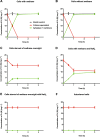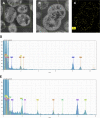Detoxification, Active Uptake, and Intracellular Accumulation of Chromium Species by a Methane-Oxidizing Bacterium
- PMID: 33127813
- PMCID: PMC7783347
- DOI: 10.1128/AEM.00947-20
Detoxification, Active Uptake, and Intracellular Accumulation of Chromium Species by a Methane-Oxidizing Bacterium
Abstract
Despite the wide-ranging proscription of hexavalent chromium, chromium(VI) remains among the major polluting heavy metals worldwide. Aerobic methane-oxidizing bacteria are widespread environmental microorganisms that can perform diverse reactions using methane as the feedstock. The methanotroph Methylococcus capsulatus Bath, like many other microorganisms, detoxifies chromium(VI) by reduction to chromium(III). Here, the interaction of chromium species with M. capsulatus Bath was examined in detail by using a range of techniques. Cell fractionation and high-performance liquid chromatography-inductively coupled plasma mass spectrometry (HPLC-ICP-MS) indicated that externally provided chromium(VI) underwent reduction and was then taken up into the cytoplasmic and membranous fractions of the cells. This was confirmed by X-ray photoelectron spectroscopy (XPS) of intact cultures that indicated negligible chromium on the surfaces of or outside the cells. Distribution of chromium and other elements within intact and sectioned cells, as observed via transmission electron microscopy (TEM) combined with energy-dispersive X-ray spectroscopy (EDX) and electron energy loss spectroscopy (EELS), was consistent with the cytoplasm/membrane location of the chromium(III), possibly as chromium phosphate. The cells could also take up chromium(III) directly from the medium in a metabolism-dependent fashion and accumulate it. These results indicate a novel pattern of interaction with chromium species distinct from that observed previously with other microorganisms. They also suggest that M. capsulatus and similar methanotrophs may contribute directly to chromium(VI) reduction and accumulation in mixed communities of microorganisms that are able to perform methane-driven remediation of chromium(VI).IMPORTANCEM. capsulatus Bath is a well-characterized aerobic methane-oxidizing bacterium that has become a model system for biotechnological development of methanotrophs to perform useful reactions for environmental cleanup and for making valuable chemicals and biological products using methane gas. Interest in such technology has increased recently owing to increasing availability of low-cost methane from fossil and biological sources. Here, it is demonstrated that this versatile methanotroph can reduce the toxic contaminating heavy metal chromium(VI) to the less toxic form chromium(III) while accumulating the chromium(III) within the cells. This is expected to diminish the bioavailability of the chromium and make it less likely to be reoxidized to chromium(VI). Thus, M. capsulatus has the capacity to perform methane-driven remediation of chromium-contaminated water and other materials and to accumulate the chromium in the low-toxicity chromium(III) form within the cells.
Keywords: Methylococcus; bioavailability; bioremediation; heavy metals; methanotrophs.
Copyright © 2021 Enbaia et al.
Figures






Similar articles
-
Remediation of chromium(VI) by a methane-oxidizing bacterium.Environ Sci Technol. 2010 Jan 1;44(1):400-5. doi: 10.1021/es901723c. Environ Sci Technol. 2010. PMID: 20039753
-
Isolation of a methane-oxidizing bacterium that bioremediates hexavalent chromium from a formerly industrialized Suburban River.Lett Appl Microbiol. 2020 Sep;71(3):287-293. doi: 10.1111/lam.13330. Epub 2020 Jun 18. Lett Appl Microbiol. 2020. PMID: 32470995
-
Methyl Selenol as a Precursor in Selenite Reduction to Se/S Species by Methane-Oxidizing Bacteria.Appl Environ Microbiol. 2019 Oct 30;85(22):e01379-19. doi: 10.1128/AEM.01379-19. Print 2019 Nov 15. Appl Environ Microbiol. 2019. PMID: 31519658 Free PMC article.
-
Insights into the obligate methanotroph Methylococcus capsulatus.Trends Microbiol. 2005 May;13(5):195-8. doi: 10.1016/j.tim.2005.03.003. Trends Microbiol. 2005. PMID: 15866035 Review.
-
Mechanisms of hexavalent chromium resistance and removal by microorganisms.Rev Environ Contam Toxicol. 2015;233:45-69. doi: 10.1007/978-3-319-10479-9_2. Rev Environ Contam Toxicol. 2015. PMID: 25367133 Review.
Cited by
-
Augmenting Cr(VI) phytoremediation potential of Ricinus communis through rhizospheric crosstalk with multi stress tolerant plant growth promoting Bacillus altitudinis M1.World J Microbiol Biotechnol. 2025 Apr 28;41(5):138. doi: 10.1007/s11274-025-04357-z. World J Microbiol Biotechnol. 2025. PMID: 40289221
-
Metal(loid) speciation and transformation by aerobic methanotrophs.Microbiome. 2021 Jul 6;9(1):156. doi: 10.1186/s40168-021-01112-y. Microbiome. 2021. PMID: 34229757 Free PMC article. Review.
References
-
- Beukes JP, Du Preez SP, van Zyl PG, Paktunc D, Fabritius T, Päätalo M, Cramer M. 2017. Review of Cr(VI) environmental practices in the chromite mining and smelting industry—relevance to development of the Ring of Fire, Canada. J Clean Prod 165:874–889. doi:10.1016/j.jclepro.2017.07.176. - DOI
-
- Coetzee JJ, Bansal N, Chirwa EMN. 2020. Chromium in environment, its toxic effect from chromite-mining and ferrochrome industries, and its possible bioremediation. Expo Health 12:51–62. doi:10.1007/s12403-018-0284-z. - DOI
-
- Varadharajan C, Beller HR, Bill M, Brodie EL, Conrad ME, Han R, Irwin C, Larsen JT, Lim HC, Molins S, Steefel CI, Van Hise A, Yang L, Nico PS. 2017. Reoxidation of chromium(III) products formed under different biogeochemical regimes. Environ Sci Technol 51:4918–4927. doi:10.1021/acs.est.6b06044. - DOI - PubMed
Publication types
MeSH terms
Substances
LinkOut - more resources
Full Text Sources
Other Literature Sources

